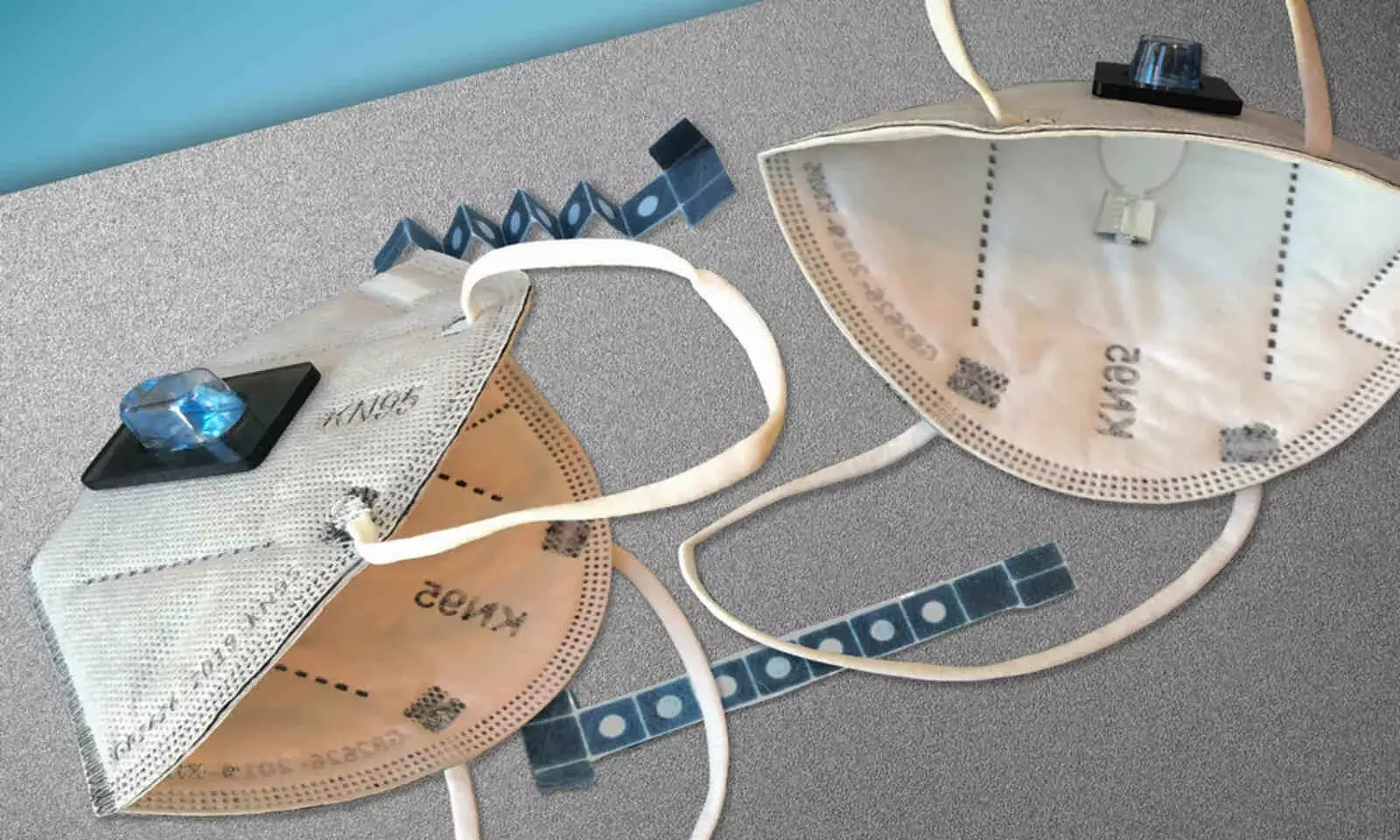Explained: How the MIT-Harvard Face Mask Detects COVID-19 in 90 Mins
The researchers had been working on the tech much before the pandemic and later used it to innovate around diagnostics

Image Credit: Felice Frankel and MIT News Office.
Scientists and researchers at Wyss Institute for Biologically Inspired Engineering at Harvard University and the Massachusetts Institute of Technology (MIT) in the US have developed a new device or a wearable biosensor (FitBit or an Apple watch also fall in the category) which is integrated into a standard face mask to detect SARS-CoV-2 virus in a patient's breath within 90 minutes.
The invention published in Nature Biotechnology journal is co-authored by 14 researchers. To understand how the technology works, FactChecker interacted with two of the authors of the study — Peter Nguyen, a research scientist at the Wyss Institute at Harvard University, and Luis Ruben Soenksen, medical device expert at MIT and a postdoctoral fellow at the Wyss Institute.
How does the mask work?
This is a button-activated mask or a wearable freeze-dried cell-free (wFDCF) mask that has a modular sensor added to it and contains everything that is needed for the test. The sample collection pad is filled into the mask in a way that is positioned directly in front of the user's mouth and nose.
This accumulates fine particles or liquid droplets also known as aerosols from the user's breath. If the user wants to perform a test, they can wear the mask for 15-30 minutes and press a button which pierces a water-filled reservoir, which flows through the sample collection pad, pushing any viral particles into the sensor for analysis. The sensor contains freeze-dried biological components that automatically perform the molecular analysis.
"At the core of our research we use cell-free synthetic biology reactions, which are self-contained abiotic chemical systems with all the molecular components required by live cells to perform biomolecule sensing," Soenksen from MIT told FactChecker via email.
The design of the mask is such that it does not look very different from an N95 mask. "The sensor itself can be integrated into any N95-equivalent face mask, so does not look too different, except for the button/water reservoir and the output strip, which is positioned on the outside of the mask," Nguyen from Wyss Institute told FactChecker.
Nguyen further explained that commercially available products like a FitBit detect physiological signals electronically. But they cannot detect exposure to a pathogen or a toxin. This requires an entire laboratory to process samples. "Our sensors can now bring that same testing power to wearables to detect and identify pathogens (any bacteria or virus) as well as toxins. In essence, our technology miniaturises an entire laboratory onto a wearable garment," said Nguyen.
The biosensor device is built on past research which was done by Jim Collins, a senior author and Wyss Institute's core faculty member. The scientists first applied this technology to diagnostics by integrating it into a tool to address the Zika virus outbreak in 2015.
"We had been working on the concept of cell-free freeze-dried wearable synthetic biology for about 1-2 years when the pandemic hit and entered lockdown in the US. That was when we decided to use that basis to innovate around masks and diagnostics. From start to finish the face-mask work actually lasted about eight months, while on shutdown and very difficult lab access restrictions," said Soenksen.
Similarly, Nguyen said, "When the COVID-19 pandemic struck in the Spring of 2020, we pivoted our technology for detection of a user's breath, which is already accumulated on the inside of a face mask anyway. With most of the key platform already developed, much of the work for the face mask was in how to adapt our technology into the right form factor that is able to process a breath sample without any moving parts, any power, and minimal user action. Within 6 months, we were able to get a working prototype that had a sensitivity equivalent to that of gold-standard WHO-approved RT-PCR tests. Unlike antigen tests, our face mask test directly detects the presence of the COVID-19 genome."
Can the mask be used more than once?
The current limitation of the technology is its single use. But both scientists are hopeful of improving the current sensor and are working on methods to potentially reload these reactions if needed. "It can only be used once, as the freeze-dried reactions are one-time use. We designed the diagnostic face mask to be inexpensive and disposable so that if desired, one could potentially perform the test daily or even multiple times a day," Nguyen said.
How much will the prototype cost?
Nguyen and Soenksen said the research team is actively looking for the right partners to move towards a design for the manufacturing phase. This process could be quite accelerated with the right partners and government support and could be easily adjusted to detect COVID-19 variants or other respiratory viruses, said the researchers.
As of now, the prototype biosensor costs about $5 or Rs 371 and it's anticipated that a mass manufactured product would be cheaper in price, said Nguyen.
Challenges
The researchers said due to the lockdown and the contagious nature of the virus, direct testing of a COVID-19 mask in a COVID-19 ward was logistically challenging. "Very limited access to reagent suppliers, testing equipment, lab access, all while protecting ourselves, our families and others can make the iterative and sometimes serendipitous process or research incredibly challenging," the MIT scientist said.
When asked whether a futuristic face mask like this can prepare us for a pandemic in the future, Soenksen said, "We certainly hope so, our technology is modular enough to potentially be adapted easily to a large variety of respiratory pathogens including new COVID variants."


